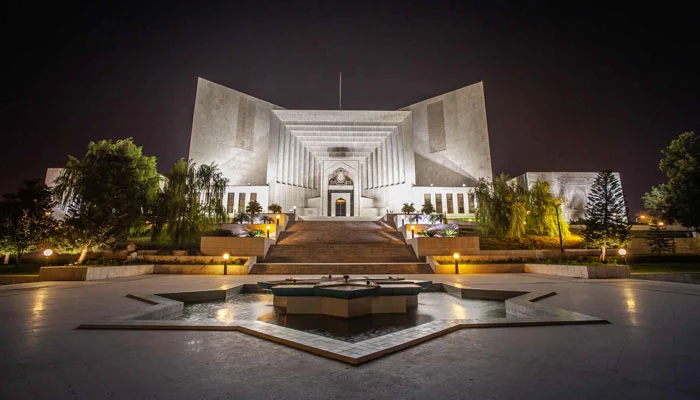ISLAMABAD ( Web News )
Supreme Court Justice Muhammad Ali Mazhar on Tuesday invoked the example of the Indian judiciary while the country’s top court debated the scope and powers of the Constitutional Bench hearing challenges to the 26th Constitutional Amendment.
The remark came as an eight-member bench, headed by Justice Amin-Ud-Din Khan, continued proceedings on multiple petitions contesting the amendment, which was passed in an overnight parliamentary session in October last year. The legislation has stirred intense debate for reshaping judicial powers, altering the appointment process of the Chief Justice of Pakistan (CJP), and establishing the Constitutional Bench itself.
Among the petitioners are the Pakistan Tehreek-e-Insaf (PTI), Jamaat-e-Islami (JI), Sunni Ittehad Council (SIC), several bar associations, and seven former presidents of the Supreme Court Bar Association (SCBA). They argue that the amendment undermines judicial independence and violates procedural norms under Article 239 of the Constitution.
During the hearing, retired Justice Syed Shabbar Raza Rizvi contended that India was the only country with a Constitutional Bench, while other nations have constitutional courts.
Responding to this, Justice Mazhar remarked, “In India too, the Constitutional Bench has special powers,” adding that the example was not unique to Pakistan.
Justice Mazhar elaborated that in India, the chief justice acts as the “Master of the Roster”, while Pakistan now follows a system where two committees decide case allocations, reducing the CJP’s unilateral control. The comparison underscored how the 26th Amendment restructured Pakistan’s judicial framework by redistributing administrative and constitutional powers among benches.
Rizvi argued that while the CB had been created under the 26th Amendment, it had not diminished the Supreme Court’s original jurisdiction. However, Justice Mazhar countered that Article 184(3) powers – previously vested in the Supreme Court – had been transferred to the CB under Article 191-A. “Regular and constitutional benches are two branches of the same tree,” Justice Mazhar observed, suggesting that both function under one judicial canopy.
Justice Musarrat Hilali questioned whether bypassing Article 191-A was even possible, pointing out that the constitutional provision had already established the CB’s authority. “Are you saying we will have to suspend the 26th Amendment first?” she asked.
Rizvi responded that Article 191-A should not be read in isolation but rather in harmony with other constitutional provisions, particularly Articles 176 and 184(3). He contended that the Supreme Court retained its jurisdictional essence despite the new structure.
Justice Amin-Ud-Din pressed the lawyer to clarify how judges lacking constitutional interpretative authority could be included in the bench. “How can judges who do not have the authority to interpret the Constitution be included in the bench?” he asked. Rizvi maintained that the CB could still refer the matter for the formation of a full court if required.
When asked to whom such a referral would be sent, Rizvi said it could go to the CJP, but Justice Mazhar noted that the CJP, being part of the Judicial Commission of Pakistan (JCP), might face a procedural barrier in this instance.
Following Rizvi’s arguments, Barrister Adnan Khan, representing petitioner Anas Ahmed, addressed the bench. He argued that the 26th Amendment case should be heard by a full court comprising all available Supreme Court judges, invoking the principle of “collective wisdom”.
“A full court is not formed, my lord,” he explained. “It is always present; it is just summoned.” Justice Hilali questioned whether such an action could bypass Article 191-A, while Justice Amin-Ud-Din observed that the bench had “no objection” if the full court possessed jurisdiction to hear the case.
Barrister Khan emphasised that both the CB and a full court could deliberate on the petitions but insisted that precedence and judicial convention favoured the latter. He also noted that the government currently held a majority in the JCP, prompting Justice Amin-Ud-Din to ask how that situation had arisen.
The 26th Amendment has drawn scrutiny for redefining judicial tenure and appointments. It limited the CJP’s term to three years, curtailed the Supreme Court’s suo motu powers, and granted the parliamentary committee authority to appoint the CJP from among the three most senior judges. The legislation also enabled the creation of the CB, now tasked with examining its own constitutional legitimacy.
So far, the bench has heard arguments from several senior lawyers and bar associations, including Hamid Khan of the Lahore High Court Bar Association and Munir A. Malik representing the Balochistan High Court Bar Association. They have urged the formation of a 16-member full court – matching the number of sitting judges at the time the amendment was passed – to ensure transparency and unanimity in adjudication.
The Supreme Court has been live-streaming the proceedings on its official YouTube channel since 8 October, offering the public a rare real-time view into the constitutional debate. On Tuesday, Justice Amin-Ud-Din remarked wryly, “Look at our patience; we are continuously hearing lies while sitting here,” after a series of intense exchanges between the bench and the lawyers.
Before adjourning the hearing till Wednesday, Justice Mazhar reiterated that the CB and the Supreme Court were part of the same institution. “Regular and constitutional benches are two branches of one tree,” he said once more, underlining that both derive legitimacy from the same judicial root.
The bench is now expected to decide whether the ongoing challenges should be heard by the full court or continue before the existing eight-member Constitutional Bench before addressing the legality of the 26th Amendment itself.

